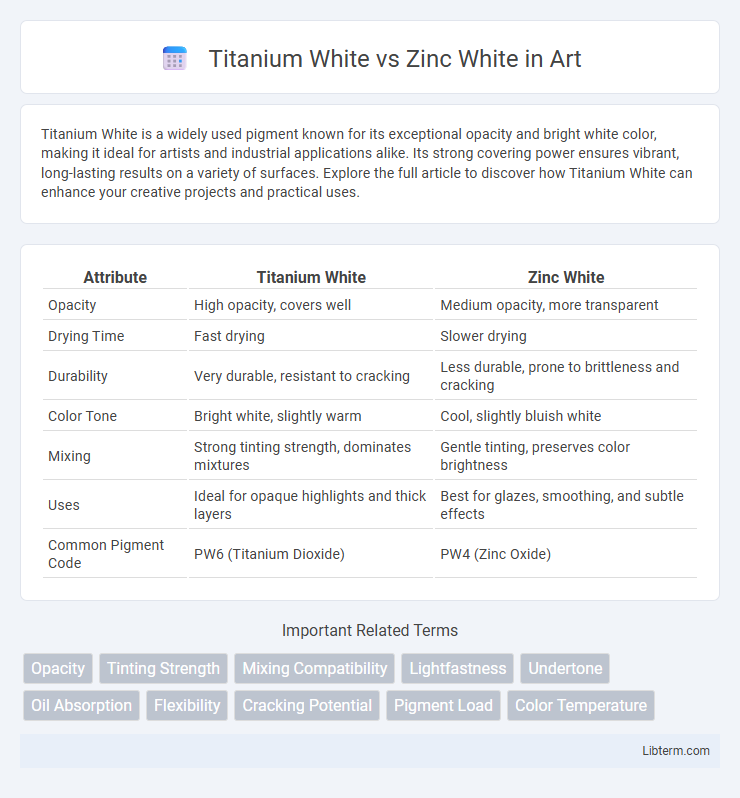Titanium White is a widely used pigment known for its exceptional opacity and bright white color, making it ideal for artists and industrial applications alike. Its strong covering power ensures vibrant, long-lasting results on a variety of surfaces. Explore the full article to discover how Titanium White can enhance your creative projects and practical uses.
Table of Comparison
| Attribute | Titanium White | Zinc White |
|---|---|---|
| Opacity | High opacity, covers well | Medium opacity, more transparent |
| Drying Time | Fast drying | Slower drying |
| Durability | Very durable, resistant to cracking | Less durable, prone to brittleness and cracking |
| Color Tone | Bright white, slightly warm | Cool, slightly bluish white |
| Mixing | Strong tinting strength, dominates mixtures | Gentle tinting, preserves color brightness |
| Uses | Ideal for opaque highlights and thick layers | Best for glazes, smoothing, and subtle effects |
| Common Pigment Code | PW6 (Titanium Dioxide) | PW4 (Zinc Oxide) |
Introduction to Titanium White and Zinc White
Titanium White, known chemically as titanium dioxide (TiO2), offers superior opacity and brightness compared to Zinc White, which is zinc oxide (ZnO). Titanium White provides excellent coverage and durability, making it a preferred pigment in oil and acrylic paints, whereas Zinc White is valued for its transparency and subtle tinting properties. Both whites serve unique roles in art and industry, with Titanium White excelling in bold coverage and Zinc White favored for delicate mixing and glazing techniques.
Historical Background of Both Whites
Titanium White, developed in the early 20th century, revolutionized paint production with its superior opacity and durability compared to earlier whites. Zinc White, dating back to the 18th century, was valued for its slow drying time and transparency but lacked the covering power and permanence of later pigments. Both whites have influenced artistic techniques and material choices throughout history, with Titanium White becoming the dominant pigment in modern art due to its stability and bright tint.
Chemical Composition Differences
Titanium White primarily consists of titanium dioxide (TiO2), known for its high opacity and strong covering power. Zinc White is composed of zinc oxide (ZnO), offering greater transparency and slower drying time in oil paints. The distinct chemical compositions influence durability, brightness, and mixing properties in artistic applications.
Opacity and Tinting Strength Comparison
Titanium White exhibits significantly higher opacity compared to Zinc White, making it ideal for bold, vibrant coverage and effective hiding power in painting. Zinc White offers lower opacity but provides superior tinting strength, allowing for subtle color mixing and delicate lightening without overpowering the original hue. Artists often choose Titanium White for strong, opaque highlights, while Zinc White is preferred for glazing and transparent layering techniques.
Drying Time and Handling Properties
Titanium White offers faster drying time compared to Zinc White, making it ideal for artists requiring quick layering and minimal wait between applications. Zinc White has a slower drying time but provides superior handling properties, including smoother blending and less cracking over time. The choice depends on the desired balance between drying speed and the flexibility or translucency of the paint film.
Lightfastness and Longevity
Titanium White offers superior lightfastness and longevity compared to Zinc White, making it highly resistant to fading over time when exposed to light. Zinc White, while providing a smoother, more transparent finish, tends to yellow and lose opacity faster due to lower durability and sensitivity to environmental factors. Artists seeking lasting vibrancy and strong opacity typically prefer Titanium White for its robust permanence.
Effects on Mixtures and Color Mixing
Titanium White offers strong opacity and high tinting strength, making it ideal for brightening colors and creating more vibrant mixtures without dulling hues. Zinc White provides a cooler, more transparent quality that helps maintain color luminosity and subtlety in blends, especially useful for glazing and delicate fades. Combining both whites can balance coverage and translucency, optimizing color mixing effects for diverse artistic needs.
Applications in Fine Art and Illustration
Titanium White offers superior opacity and brightness, making it ideal for bold highlights and altering colors in fine art and illustration projects. Zinc White provides a translucent, cooler hue favored for glazing techniques and subtle blending in delicate washes or detailed illustrations. Artists often choose Titanium White for heavy impasto work, while Zinc White supports smooth layering and fine tonal gradations.
Health and Safety Considerations
Titanium White is generally considered safer for health as it is non-toxic and chemically stable, posing minimal inhalation or skin contact risks during use. Zinc White, although less opaque, can release zinc oxide fumes when heated, which may cause respiratory irritation and metal fume fever if proper ventilation is not maintained. Artists should handle both pigments with care, using protective measures such as gloves and masks to minimize exposure to dust and fumes.
Choosing the Right White for Your Artwork
Titanium White offers strong opacity and brightness, making it ideal for bold highlights and mixing vibrant colors, while Zinc White provides a cooler, more transparent finish suited for delicate glazes and smooth blending. Artists seeking durability and high coverage often prefer Titanium White, whereas those aiming for subtle tonality and softer transitions benefit from Zinc White's gentle properties. Selecting the right white depends on your painting technique, desired light reflection, and layering needs within your artwork.
Titanium White Infographic

 libterm.com
libterm.com